Abstract
The article notes the engineering education importance for the Republic of Crimea. Attention is paid to the demand's low level for engineering professions among potential applicants entering higher educational institutions for engineering specialties. The scientific and pedagogical literature's brief analysis on the future specialty's choice, on the prospects for professional growth, on the problem of preparing applicants for an engineering education and the specialized schools and classes' development is given. The information and educational space structure for training future engineers in the Crimean region is considered. The informational and educational space state of the Republic of Crimea is analyzed. This revealed the need to develop a conceptual model for managing the system of training schoolchildren entering engineering specialties. In the informational and educational space regional system, a triad is involved, has become the subject of analysis, and subsequently an instrument to achieve the most high-quality and cost-effective students' training in educational institutions of higher education in the region. In the course of the study, interviews and questionnaires were carried out for schoolteachers, higher education teachers, schoolchildren and students who entered the engineering specialties in higher educational organizations in 2019–2020.
Keywords: The system of informational and educational space, the preparation of schoolchildren, applicants entering engineering specialties
Introduction
Currently, according to the goal of the State program "Socio-economic development of the Republic of Crimea and the city of Sevastopol", the conditions' creation for balanced sustainable economy and social sphere's development of the Republic of Crimea and Sevastopol, dated January 30, 2019 No. 63, there is an active industry development in the Republic Crimea, which brings the prestige of engineering and technical specialties to the first place (The Government of the Russian Federation, 2005). State budgetary educational institution of higher education of the Republic of Crimea “The Crimean Engineering and Pedagogical University named after Fevzi Yakubov” (CEPU named after Fevzi Yakubov) provides training for specialists in engineering and technical specialties. The entry campaign’s analysis of 2018-2019 revealed a submitting documents' low activity of applicants for engineering specialties. Moreover, Crimean applicants in 2019 showed a low level of the average exam score in mathematics and physics. Consequently, a small number of schoolchildren entering engineering specialties and their poor preparation are of concern, which may negatively affect the needs of highly qualified engineering personnel in the Republic of Crimea.
Problem Statement
The problem of choosing a future specialty and prospects for professional growth is always important and relevant. Professional development of the personality was discussed from the perspective of the activity approach in the works of S. L. Rubinstein, A. N. Leontyev (as cited in Zeer et el., 2019). The competency-based approach is viewed by E. F. Zeer, A. V. Khutorskoy (as cited in Khutorskoy & Khutorskaya, 2003; Vakareva & Bura, 2016; Zeer & Symanyuk, 2015); personally oriented approach was considered by G. A. Tsukerman, I. S. Yakimanskaya, I. Yu. Sokolova (as cited in Bannikova & Boronina, 2016).
Particular attention in the scientific and pedagogical literature is given to the insufficient number of applicants' issue prepared to receive an engineering education. The problems of choosing a future professional trajectory and the form of professional orientation are studied (Nadeeva, 2016; Troeshestova & Vasilieva, 2017). Close attention is paid to the vocational guidance of schoolchildren, assessing the needs of enterprises in engineering personnel and its impact on the vocational guidance system (Alexandrov, 2017). The questions of insufficient awareness of schoolchildren about the engineering activity specifics are touched on (Baineva, 2017). All the possible experience of career guidance work aimed at popularizing technical education and improving its quality is analyzed (Graskin & Graskina, 2018; Yagubov & Dubikovsky, 2017).
Research Questions
Much attention is paid to the opening of new specialized schools and classes, where the vector of the student's personal and professional development, focused on the engineering and technical specialties necessary for the region, is set (Hryshchenko, 2015; Ilyashenko, 2018; Kudryakova & Zhagalkovich, 2014; Mavrin et al., 2008; Shevchenko et al., 2019). The extracurricular work model with the students of engineering specialties using active teaching methods was considered in the scientists' works (López-Fernández et al., 2015; Raud, 2017; Vodovozov et al., 2018). Many researchers pay significant attention to the motivation development as a critical factor in academic performance in the context of higher education, where active learning is to be encouraged (Mikhnenko & Absaliamova, 2018).
Purpose of the Study
The aim of the article is to justify the effective structure of the information and educational space for the students' training. The triad is involved in the regional system of information and educational space, this is the subject of analysis and management, as well as an instrument for achieving the most high-quality and cost-effective training of students entering engineering and technical specialties in higher educational organizations of the region.
Research Methods
The information and educational space (IES) can be defined as an open set of information objects: schools, preparatory courses, circles, open-secondary schools and general educational institutions. IES includes the sources (educational and methodical publications, assignments, experimental and control works for schoolchildren) and information receivers (students, teachers and public teachers); as well as information flows (,, etc.) and information fields (,). The objects' interaction determines the relationship between them.
Information flows in the regional system of training schoolchildren entering engineering professions are also the subject of analysis and a tool to achieve the most productive and cost-effective training of applicants studying the engineering professions to meet the needs of the Crimean labor market.
The information and educational space structure for training future engineers in the region consists of schools, a higher school and an enterprise. A student can study in ordinary classes or with in-depth study of mathematics, physics attend sections or circles, preparatory courses at a school or educational institutions of higher education, is a member of the Small Academy of Sciences (SAS), mainly to gain knowledge in the subjects that he or she will pass the exam. In this case, the teacher has a special responsibility, so he or she lays the foundation for mathematical, technical and design thinking. It should be noted that in this space, enterprises do not affect the future graduates' training of engineering specialties. And, in the space between the university and the enterprise, there are close ties, first of all, these are basic departments, practical training. Schematically, Figure 1 shows the informational and educational space structure for the training future engineers in the Republic of Crimea.
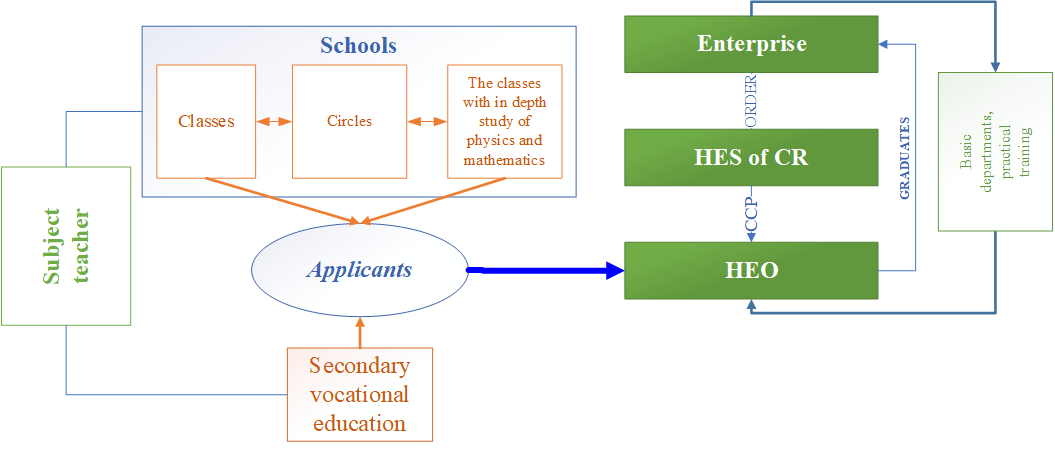
Findings
Studies conducted at the Fevzi Yakubov CEPU in 2018–2019 among the first year students of engineering specialties showed that 90.4 % of the students graduated from the ordinary classes and only 9.6 % studied in the classes with in-depth study of mathematics, physics or computer science. Among the university students 53 % graduated from the rural school, 47 % graduated from the city school and 35.6 % attended circles and sections only. The first school with an engineering bias was opened in Sevastopol in January 2020.
The first year Students of engineering specialties completed the Questionnaire 1, in which it is necessary to answer such questions as «To pass the exam did you prepare independently? » (Yes, No); «Were you engaged in preparatory courses at school? » (Yes, No); «Were you engaged in preparatory courses at the university? » (Yes, No); «Did you prepare with a tutor? ». For Questionnaire 2 the questions were: «Did you study in a class with in-depth study of mathematics, physics or computer science? » (Yes, No); «Have you attended the circles or sections in mathematics, physics, computer science? » (Yes, No); «Did you study at the Small Academy of Sciences (SAS)? » (Yes, No).
Students' answers were distributed, thus: preparing for admission with a tutor: Yes − 31.5 %, No − 68.5 %; were engaged in preparatory courses at the university: Yes − 12.3 %, No − 87.7 %; were engaged in preparatory courses at school: Yes − 47.9 %, No − 52.1 %; prepared independently: Yes − 56.2 %, No − 43.8 %. It should be noted that applicants during the preparation period could attend preparatory courses at school and prepare for admission with a tutor or prepare for admission independently and attend preparatory courses at the university.
Questionnaire 2 results: «Did you study in a class with in-depth study of mathematics, physics or computer science? » (Yes − 9.6 %; No − 90.4 %); «Have you attended circles / sections in mathematics, physics, computer science?» (Yes − 35.6 %, No − 63.4 %); «Were you engaged in the Small Academy of Sciences (SAS)? » (Yes − 5.5 %, No − 94.5 %). Some students attended circles or sections in mathematics, physics, computer science and studied at the Small Academy of Sciences at the same time.
- The data is presented in table 01.
- The answers to Questionnaire 1 and Questionnaire 2 are presented in the diagrams in Figure 02 and Figure 03.
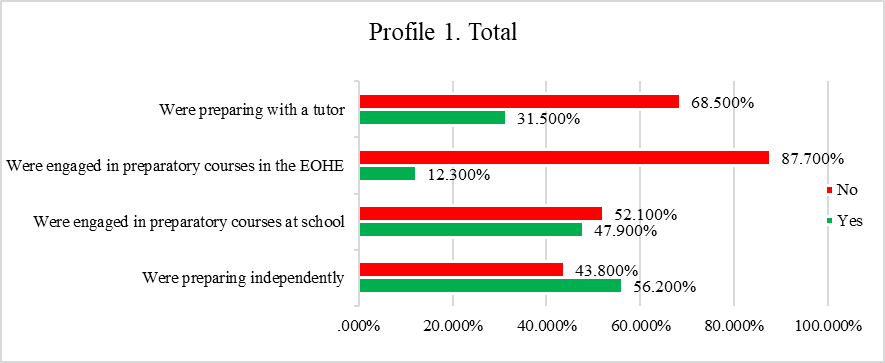
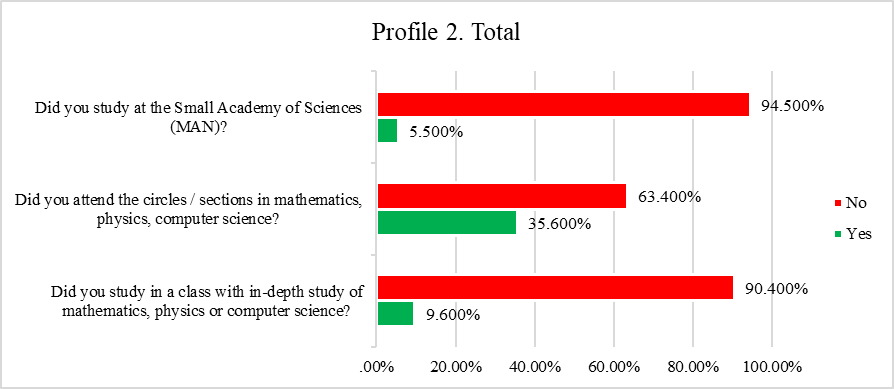
With the help of Questionnaire 1, it was revealed that 29.4 % and 33.3 % of the rural school graduates from the city attended the tutoring with a tutor. The urban schoolchildren attended only 5.9 % of the preparatory courses, and the rural students attended 17.9 %. To the question «Did you attend the preparatory courses at school?» the city students are 44.2 %, and the rural students are 51.3 %. The diagrams are shown in Figures 04 and 05.
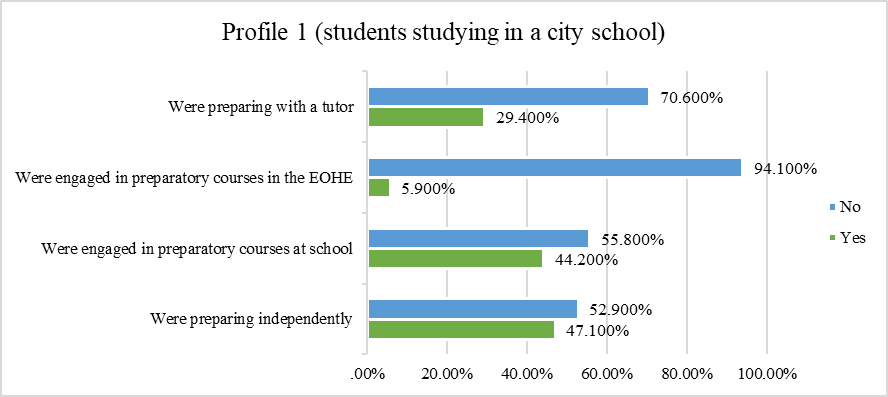
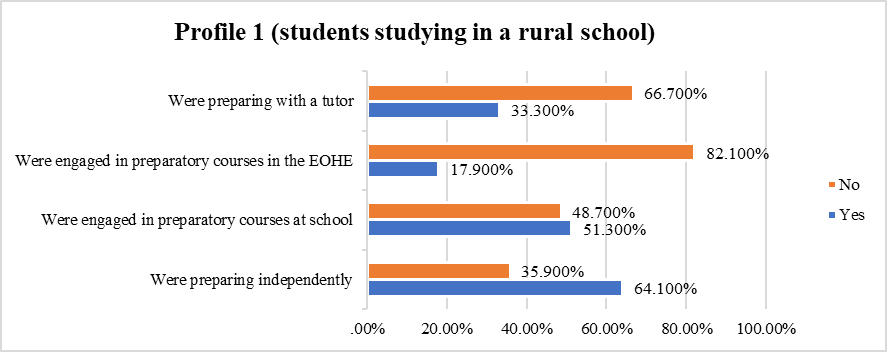
Analyzing the answers on Questionnaire 2, we note that 5.9 % of the urban schoolchildren were involved in SAS, and 5.1 % were of the rural students. 35.3 % attended sections or circles in mathematics, physics, computer science, an approximately equal number of students in the urban schools, and rural were 35.9 %. 17.6 % studied in the class with in-depth study of mathematics, physics, computer science in the city, in the countryside was 2.6 %. Diagrams are shown in figures 06 and 07.
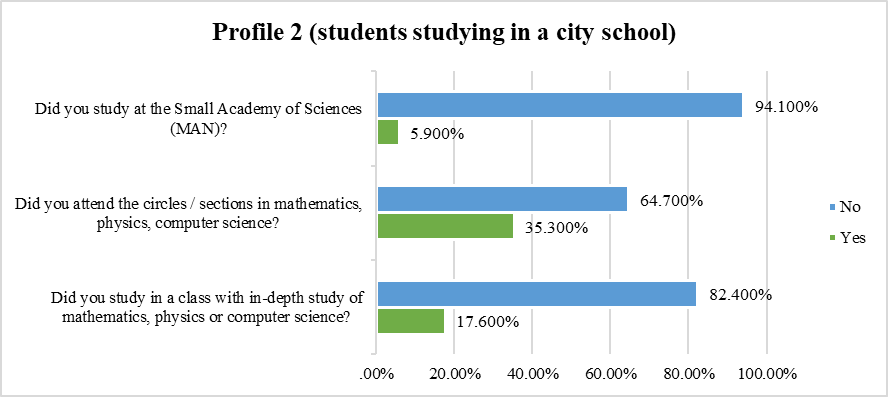
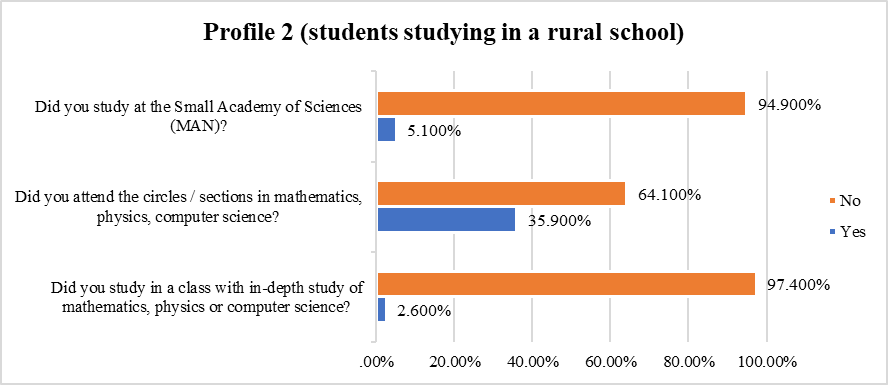
Conclusion
After analyzing the information and educational space's state of the Republic of Crimea, after interviewing and questioning school teachers, university teachers, schoolchildren, students who entered engineering specialties in higher educational institutions, we can state that:
1. The first engineering classes were only opened in January 2020 in the city of Sevastopol.
2. Slightly more than half of the university entrants graduated from the rural schools.
3. The preparatory courses at school are more actively attended at school than at university.
4. Only 31.5 % of the students surveyed were engaged with a tutor.
5. Weak training of applicants in mathematics and physics and lack of knowledge of the drawing basics are noted.
6. An analysis of the educational and methodical literature for teachers and schoolchildren showed an insufficient number of educational publications to form students' skills in solving engineering problems and manifesting themselves in scientific and technical creativity.
It is possible to change this situation for the Crimean region if you create a model for managing the regional information and educational system for training schoolchildren entering engineering specialties. In this model, with the support of leading enterprises, it is necessary to:
1. Develop and regularly monitor students in grades 9–11 to identify students planning to enter engineering specialties.
2. To manage the preparation of schoolchildren through a system of developed methodologies and educational and methodological support for the teacher, which provide not only the sum of knowledge, but their understanding and ability to apply in future professional activities when solving engineering problems, for example, after school hours, in additional classes and sections.
3. Manage the preparation of students, for example, through an online system of developed individual tasks, tests for students.
4. Engage in participation in research and project activities, in competitions, at the conferences at the university and regional levels.
5. To carry out correction to improve and modernize the work done. In conclusion, it should be noted that in order to implement the management model of the regional information and educational system for preparing students entering engineering specialties, it is necessary to create an informational and educational space that combines the resources of school and higher education, as well as the leading enterprises of Crimea, and their management.
References
Alexandrov, A. Y. (2017). Chuvash State University named after I.N. Ulyanov - an innovative multidisciplinary university, integrated into the economy of the region and the country. Higher ed. in Russ., 7, 99–105.
Baineva, I. I. (2017). The role of engineering classes in the modern system of technical education. Educational experiment in education, 4(84), 20–29.
Bannikova, L. N., & Boronina, L. N. (2016). Engineer Training for Innovation: Request Assessment. Univer. Manag.: Pract. and Anal., 3(103), 32–42.
Graskin, S. S., & Graskina, E. E. (2018). Organization of a modern developing educational environment in engineering classes. In Modeling and designing in the educational environment. Mater. of the III All-Russ. (with int. participat.) sci.-pract., methodology. Conf. for the sci. and pedag. community (pp. 46–55). Moscow.
Hryshchenko, S. (2015). Modern approaches in the study of engineering students. Metallurg. and Mining Industry, 12, 144–146.
Ilyashenko, L. K. (2018). Managerial preparation of engineers with eyes of students. Int. J. of Mechan. Engineer. and Technol., 9(4),1080–1087.
Khutorskoy, A. V., & Khutorskaya, L. N. (2003). Competency-based approach to modeling postgraduate education. Theory and Practice of Postgraduate Education: Collection of Scientific Articles, 256–260.
Kudryakova, N. V., & Zhagalkovich, P. S. (2014). Training of industry specialists in the program “SCHOOL-UNIVERSITY-ENTERPRISE”. Modern high technol., 7-3, 55–56.
López-Fernández, D., Alarcon, P., & Tovar, E. (2015). Motivation in engineering education. A framework supported by evaluation. http://oa.upm.es/45178/1/ INVE_MEM_2015_184896.pdf
Mavrin, G., Khabibullin, R., Makarova, I., & Akhmetzyanova, G. (2008). Specialized engineering classes. Higher ed. in Russ., 8, 82–87.
Mikhnenko, G., & Absaliamova, Y. (2018). The formation of intellectual mobility of engineering students through integration of foreign language education and professional training. Advan. education., 9, 33–38.
Nadeeva, O. G. (2016). A study of high school students' knowledge of professional requirements for engineering workers. Teacher Ed. in Russ., 6, 77–82.
Raud, Z. (2017). Promotion of the students' success in higher engineering education. 2017 IEEE 58th Int. Sci. Conf. on Power and Electrical Engineering of Riga Technical University (RTUCON) (pp. 1–6).
Shevchenko, E. V., Talalaeva, V. A., & Gritsa, A. I. (2019). Adaptation of graduates of specialized and specialized classes at a university. Quality Management System: Experience and Prospects, 196.
The Government of the Russian Federation (2005). Social and economic development of the Republic of Crimea and the city of federal significance Sevastopol. http://government.ru/rugovclassifier/58/main
Troeshestova, D. A., & Vasilieva, O. N. (2017). The system of vocational guidance for students, attracting and supporting talented youth. Higher ed. in Russ., 7, 125–131.
Vakareva, E. S., & Bura, L. V. (2016). Problems of psychodiagnostics of spatial thinking of personality. The impact of science on innovative development, 160–163.
Vodovozov, V., Raud, Z., & Detsiuk, T. (2018). The model of extracurricular work with students of engineering specialties. Advan. Ed., 10, 55–61.
Yagubov, E. Z., & Dubikovsky, S. Y. (2017). Profile classes as a tool for the development of the educational environment in order to train workers and engineers. Higher ed. in Russ., 4, 120–125.
Zeer, E. F., & Symanyuk, E. E. (2015). Implementation of the competency-based approach in the system of innovative education. Innovat. projects and programs in ed., 4, 6–11.
Zeer, E. F., Symanyuk, E. E., Berdnikova, D. V., & Borisov, G. I. (2019). Formation of trans-professional competencies among future engineers. Actual probl. of psychol. Knowledge, 2(51), 27–35.
Copyright information

This work is licensed under a Creative Commons Attribution-NonCommercial-NoDerivatives 4.0 International License.
About this article
Publication Date
17 May 2021
Article Doi
eBook ISBN
978-1-80296-106-5
Publisher
European Publisher
Volume
107
Print ISBN (optional)
-
Edition Number
1st Edition
Pages
1-2896
Subjects
Science, philosophy, academic community, scientific progress, education, methodology of science, academic communication
Cite this article as:
Gordienko, T., & Mezentseva, A. (2021). Conceptual Model Of Managing A System For Preparing Students For Engineering Specialties. In D. K. Bataev, S. A. Gapurov, A. D. Osmaev, V. K. Akaev, L. M. Idigova, M. R. Ovhadov, A. R. Salgiriev, & M. M. Betilmerzaeva (Eds.), Knowledge, Man and Civilization - ISCKMC 2020, vol 107. European Proceedings of Social and Behavioural Sciences (pp. 1085-1093). European Publisher. https://doi.org/10.15405/epsbs.2021.05.145

